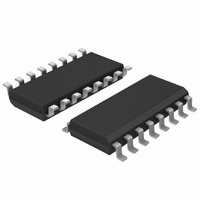74HCT112D,652 NXP Semiconductors, 74HCT112D,652 Datasheet - Page 2

74HCT112D,652
Manufacturer Part Number
74HCT112D,652
Description
IC FLIP FLOP DUAL JK NEG 16SOIC
Manufacturer
NXP Semiconductors
Series
74HCTr
Type
JK Typer
Datasheets
1.74HCT4046ADB112.pdf
(19 pages)
2.74HCT4046ADB112.pdf
(23 pages)
3.74HCT112PW112.pdf
(15 pages)
Specifications of 74HCT112D,652
Package / Case
16-SOIC (3.9mm Width)
Function
Set(Preset) and Reset
Output Type
Differential
Number Of Elements
2
Number Of Bits Per Element
1
Frequency - Clock
64MHz
Trigger Type
Negative Edge
Voltage - Supply
4.5 V ~ 5.5 V
Operating Temperature
-40°C ~ 125°C
Mounting Type
Surface Mount
Number Of Circuits
2
Logic Family
74HCT
Logic Type
Dual JK Flip-Flop
Polarity
Inverting/Non-Inverting
Input Type
Single-Ended
Propagation Delay Time
19 ns
High Level Output Current
- 6 mA
Supply Voltage (max)
5.5 V
Maximum Operating Temperature
+ 125 C
Mounting Style
SMD/SMT
Minimum Operating Temperature
- 40 C
Supply Voltage (min)
4.5 V
Lead Free Status / RoHS Status
Lead free / RoHS Compliant
Current - Output High, Low
-
Delay Time - Propagation
-
Lead Free Status / Rohs Status
Lead free / RoHS Compliant
Other names
568-1506-5
74HCT112D
933714970652
74HCT112D
933714970652
Philips Semiconductors
FEATURES
GENERAL DESCRIPTION
The 74HC/HCT112 are high-speed Si-gate CMOS devices
and are pin compatible with low power Schottky TTL
(LSTTL). They are specified in compliance with JEDEC
standard no. 7A.
The 74HC/HCT112 are dual negative-edge triggered
JK-type flip-flops featuring individual nJ, nK, clock (nCP),
set (nS
QUICK REFERENCE DATA
GND = 0 V; T
Notes
1. C
2. For HC the condition is V
1998 Jun 10
SYMBOL
t
f
C
C
PHL
max
Asynchronous set and reset
Output capability: standard
I
I
PD
Dual JK flip-flop with set and reset;
negative-edge trigger
CC
f
f
C
V
For HCT the condition is V
i
o
/ t
CC
PD
L
category: flip-flops
= input frequency in MHz
= output frequency in MHz
(C
PLH
D
P
) and reset (nR
= output load capacitance in pF
L
= supply voltage in V
is used to determine the dynamic power dissipation (P
D
= C
V
CC
amb
PD
2
PARAMETER
propagation delay
maximum clock frequency
input capacitance
power dissipation capacitance per flip-flop notes 1 and 2
= 25 C; t
nCP to nQ, nQ
nS
nR
V
f
o
CC
) = sum of outputs
D
D
to nQ, nQ
2
to nQ, nQ
D
) inputs.
f
r
i
= t
I
= GND to V
I
f
= GND to V
= 6 ns
(C
L
V
CC
2
CC
CC
f
o
) where:
1.5 V
2
CONDITIONS
C
The set and reset inputs, when LOW, set or reset the
outputs as shown in the function table regardless of the
levels at the other inputs.
A HIGH level at the clock (nCP) input enables the nJ and
nK inputs and data will be accepted. The nJ and nK inputs
control the state changes of the flip-flops as shown in the
function table. The nJ and nK inputs must be stable one
set-up time prior to the HIGH-to-LOW clock transition for
predictable operation.
Output state changes are initiated by the HIGH-to-LOW
transition of nCP.
Schmitt-trigger action in the clock input makes the circuit
highly tolerant to slower clock rise and fall times.
L
D
= 15 pF; V
in W):
CC
= 5 V
17
15
18
66
3.5
27
HC
TYPICAL
74HC/HCT112
Product specification
19
15
19
70
3.5
30
HCT
ns
ns
ns
MHz
pF
pF
UNIT





















